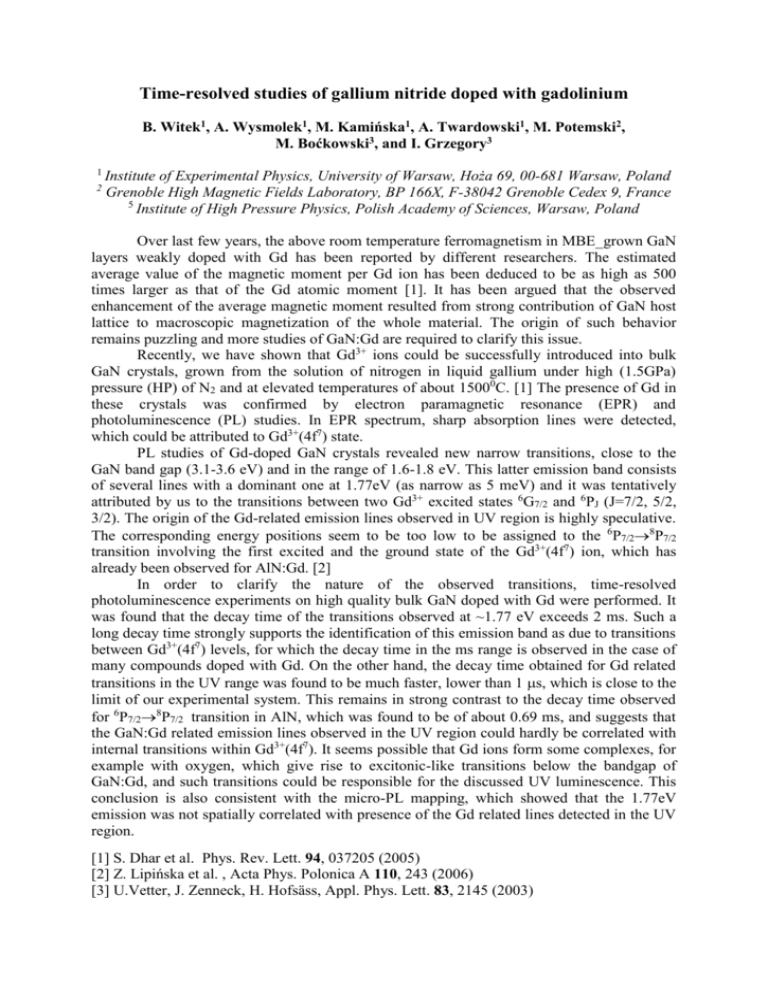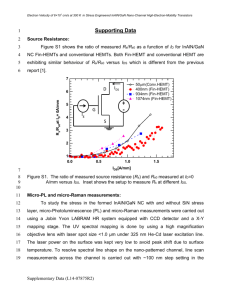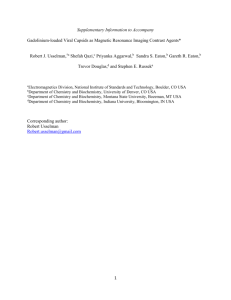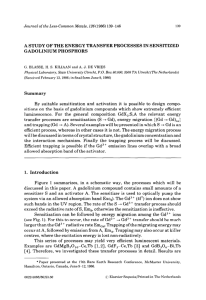Magnetooptical studies of bulk GaN doped with gadolinium
advertisement

Time-resolved studies of gallium nitride doped with gadolinium B. Witek1, A. Wysmolek1, M. Kamińska1, A. Twardowski1, M. Potemski2, M. Boćkowski3, and I. Grzegory3 1 2 Institute of Experimental Physics, University of Warsaw, Hoża 69, 00-681 Warsaw, Poland Grenoble High Magnetic Fields Laboratory, BP 166X, F-38042 Grenoble Cedex 9, France 5 Institute of High Pressure Physics, Polish Academy of Sciences, Warsaw, Poland Over last few years, the above room temperature ferromagnetism in MBE_grown GaN layers weakly doped with Gd has been reported by different researchers. The estimated average value of the magnetic moment per Gd ion has been deduced to be as high as 500 times larger as that of the Gd atomic moment [1]. It has been argued that the observed enhancement of the average magnetic moment resulted from strong contribution of GaN host lattice to macroscopic magnetization of the whole material. The origin of such behavior remains puzzling and more studies of GaN:Gd are required to clarify this issue. Recently, we have shown that Gd3+ ions could be successfully introduced into bulk GaN crystals, grown from the solution of nitrogen in liquid gallium under high (1.5GPa) pressure (HP) of N2 and at elevated temperatures of about 15000C. [1] The presence of Gd in these crystals was confirmed by electron paramagnetic resonance (EPR) and photoluminescence (PL) studies. In EPR spectrum, sharp absorption lines were detected, which could be attributed to Gd3+(4f7) state. PL studies of Gd-doped GaN crystals revealed new narrow transitions, close to the GaN band gap (3.1-3.6 eV) and in the range of 1.6-1.8 eV. This latter emission band consists of several lines with a dominant one at 1.77eV (as narrow as 5 meV) and it was tentatively attributed by us to the transitions between two Gd3+ excited states 6G7/2 and 6PJ (J=7/2, 5/2, 3/2). The origin of the Gd-related emission lines observed in UV region is highly speculative. The corresponding energy positions seem to be too low to be assigned to the 6P7/28P7/2 transition involving the first excited and the ground state of the Gd3+(4f7) ion, which has already been observed for AlN:Gd. [2] In order to clarify the nature of the observed transitions, time-resolved photoluminescence experiments on high quality bulk GaN doped with Gd were performed. It was found that the decay time of the transitions observed at ~1.77 eV exceeds 2 ms. Such a long decay time strongly supports the identification of this emission band as due to transitions between Gd3+(4f7) levels, for which the decay time in the ms range is observed in the case of many compounds doped with Gd. On the other hand, the decay time obtained for Gd related transitions in the UV range was found to be much faster, lower than 1 s, which is close to the limit of our experimental system. This remains in strong contrast to the decay time observed for 6P7/28P7/2 transition in AlN, which was found to be of about 0.69 ms, and suggests that the GaN:Gd related emission lines observed in the UV region could hardly be correlated with internal transitions within Gd3+(4f7). It seems possible that Gd ions form some complexes, for example with oxygen, which give rise to excitonic-like transitions below the bandgap of GaN:Gd, and such transitions could be responsible for the discussed UV luminescence. This conclusion is also consistent with the micro-PL mapping, which showed that the 1.77eV emission was not spatially correlated with presence of the Gd related lines detected in the UV region. [1] S. Dhar et al. Phys. Rev. Lett. 94, 037205 (2005) [2] Z. Lipińska et al. , Acta Phys. Polonica A 110, 243 (2006) [3] U.Vetter, J. Zenneck, H. Hofsäss, Appl. Phys. Lett. 83, 2145 (2003)











